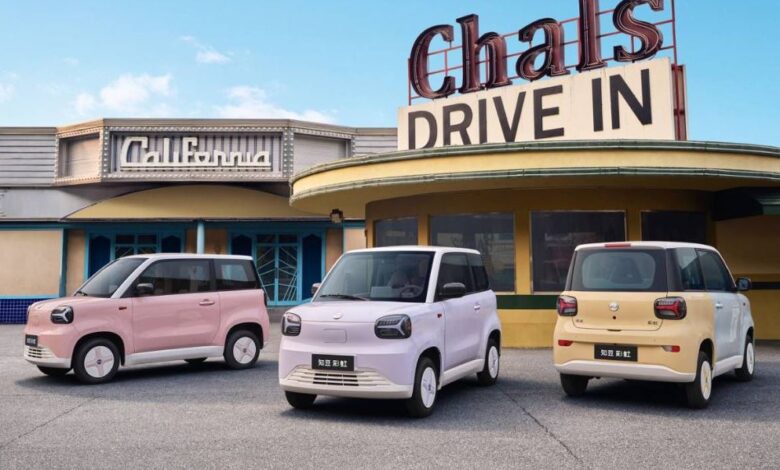As Elon Musk Abandons the $25K Tesla, This EV Costs Just $4,400

As Elon Musk steps away, yet again, from the idea of a $25,000 Tesla, let’s take this opportunity to zoom out and appreciate what a truly affordable EV can be. For this we need to ignore the Nissan Leaf—currently the cheapest EV in the US at $29,280—and skip over Europe, home to the adorable but flawed $10,000 Citroen Ami, and head to China.
Here you’ll find the equally cheap BYD Seagull, a small electric hatchback styled by ex-Lamborghini designer Wolfgang Egger and with a 200-mile range—four times that of the Ami.
But what if even that is too expensive? Then allow us to present the Zhidou Rainbow. This is a compact city EV priced from 31,900 yuan before subsidies—that’s just $4,400. For a new electric car. WIRED literally recommends ebikes that cost more that this.
The Rainbow has three doors and four seats, and an interior with a 5-inch digital driver display and a 9-inch touchscreen for the infotainment system. There’s even a connected smartphone app, charge scheduling, and the promise of over-the-air (OTA) software updates.
Splash out on the flagship Color Cloud Edition (which costs $5,800, or about half the price of Porsche’s fanciest bicycle) and you can have each panel of your Rainbow painted a different color. A bit like Volkswagen did with the somewhat mad Polo Harlequin in the mid ’90s.
Cheaper Than an Ebike
There are two models on offer. The first has that headline $4,400 price tag and is powered by a 20-kW (27-horsepower) motor with 85 Nm (63 ft-lbs) of torque and fed by a tiny 9.98-kWh battery. Spend 39,900 yuan ($5,500) and your Rainbow is fitted with a 30-kW (40-horsepower) motor with 125 Nm of torque and a 17-kWh battery pack. Range is between 78 and 127 miles using China’s generous CLTC testing standard.
Be under no illusion here, these are tiny numbers. Even the larger battery is the same capacity of that of a plug-in hybrid Honda CR-V, which also employs a 2.0-liter engine to help it get around. But the range isn’t terrible. Even if the testing standard is generous, and the larger battery has a more realistic range of 100 miles, that’s about the same as the Honda e, which cost a whopping £37,000 ($46,000) before it went off sale at the end of 2023.
There are two Rainbow models: One powered by a 20-kW (27-horsepower) motor fed by a tiny 9.98-kWh battery; and a pimped 30-kW (40-horsepower) motor version with 17-kWh battery.
Courtesy of Zhidou
The Rainbow measures 3,224 millimeters (126.9 inches) long, 1,515 millimeters (59.7 inches) wide, and 1,630 millimeters (64.2 inches) tall. This is, of course, tiny by modern, Western standards, and on a US highway packed with pickups the Rainbow would feel downright vulnerable.
But such small cars aren’t unusual elsewhere. The Rainbow is larger in every direction than an original Mini or Fiat 500, each of which sold in their millions, and it’s actually a fraction too wide to qualify as a Kei car. That’s the smallest category of vehicle allowed on expressways in Japan, and which qualify for lower tax and insurance rates, along with parking advantages, since they take up so little space on Japan’s busy streets.
Could a fleet of tiny, cheap electric cars work in Europe and the US? It’s an idea that has been toyed with for years. First there was Alec Issigonis and the genius of his Mini back in the late 1950s, and even smaller so-called bubble cars like the BMW Isetta remained popular in Britain into the ’60s, their tiny and frugal engines an answer to the Suez oil crisis and postwar austerity. Soon though, a resurgent economy, especially in the US, saw drivers lust after ever-larger cars to match their expanding wealth.
The Rainbow’s interior boasts a 5-inch digital driver display and a 9-inch touchscreen for the infotainment system. There’s even a connected smartphone app and charge scheduling.
Courtesy of Zhidou
But desire for smaller vehicles remained strong in Europe, where hatchbacks like the Volkswagen Golf and Ford Fiesta enjoyed decades of success. Mercedes then seemingly struck gold in the late 1990s by going even smaller with the Smart Fortwo, a two-seater so compact it could be parked nose-on to the curb. Its radical design proved popular and remained in production for more than 20 years before being axed in 2023 with no immediate successor.
Then there was the T25, a tiny city car concept revealed by Formula One designer Gordon Murray back in 2008, and intended to go on sale in 2012 for £5,500 ($6,800 today). Later came plans for a hideous electric version called the T27, with 34 horsepower and a range of 100 miles.
Both cars were to be built using a new and efficient manufacturing process called iStream, and the T27 even passed a 35-mph crash test with zero cabin intrusion. Ultimately though, neither microcar found a way into mass production, and Murray went back to building supercars instead.
Dawn of a Microcar Age?
Fast-forward a decade, and is now the time for the microcar to come back into fashion? Such vehicles are already popular in China, with best-sellers including the Wuling Mini EV, which WIRED has tested, and the Geely Panda. They fall somewhere between the already-classified, low-speed electric vehicles (LSEVs) and what you might deem a “proper” car.
Such EVs are a step above golf carts and anything else described in Europe as a quadricycle, which includes the Citroen Ami and closely related Fiat Topolino, but wouldn’t pass the stringent crash and safety standards set by Euro NCAP.
But that doesn’t mean the resurgent microcar industry lacks credibility. You might not be familiar with Zhidou, but this isn’t just another Chinese EV startup to have seemingly appeared from nowhere. Instead, it’s a formerly bankrupt Chinese EV startup that has been given a surprise new lease on life.
The Rainbow’s range is between 78 and 127 miles using China’s generous CLTC testing standard.
Courtesy of Zhidou
Zhidou was founded in 2006, and later revealed a very small and modestly equipped electric microcar called the D1. This was succeeded by the D2, a similarly small EV that took Zhidou beyond China and into Europe, thanks to its use in Italy by Sharengo, a car-sharing company. Later came the D2S and D3, before the company went bankrupt in 2019 and lay dormant for half a decade.
Now though, a restructuring effort led by Geely and Aima Technology Group has brought Zhidou back to life. You will no doubt recognize Geely as the Chinese auto giant at the helm of Volvo, Polestar, Lotus, Lynk & Co, Zeekr, and LEVC, the company that makes London’s electric taxis. Geely is also an investor in Aston Martin and Mercedes-Benz, and manages Smart via a joint venture with Mercedes.
Meanwhile, Aima Technology Group is a Chinese manufacturer and seller of electric bicycles, mopeds, and motorbikes that was founded in 1999. Although larger than what it usually has in stock, it doesn’t take much imagination to see the Zhidou Rainbow microcar appearing in Aima’s retail locations, among rows of ebikes.
Established car companies are unlikely to give the microcar movement too much attention, given their lower value, limited performance, and inherent lack of safety. But low-cost vehicles like the Rainbow—plus earlier attempts to build more accomplished electric microcars like Murray’s T27, and the popularity of the Smart—still offer plenty of food for thought, especially in emerging but densely populated markets looking to upgrade from mopeds.
There are even a handful of new electric microcars being built in the West, including those by New York–based Wink Motors, whose new street-legal Mark 3 weighs 1,900 pounds, goes 65 miles on a charge, and costs $12,995 (preorder now to save a grand). It’s not a $4,400 Rainbow, but it’s capable of completing the average US daily commute of about 40 miles, with charge to spare.
If Elon Musk can save his Tesla “master plan” of reinvesting profits earned from expensive EVs into the development of cheaper models (which looks uncertain now that the company has taken a step back on one-piece gigacasting)—instead of chasing follies like the Cybertruck and Roadster—a “more affordable” city car, and perhaps even a Model 1 microcar, makes sense.
You could say that following the Rainbow might even lead Tesla to a pot of gold.



